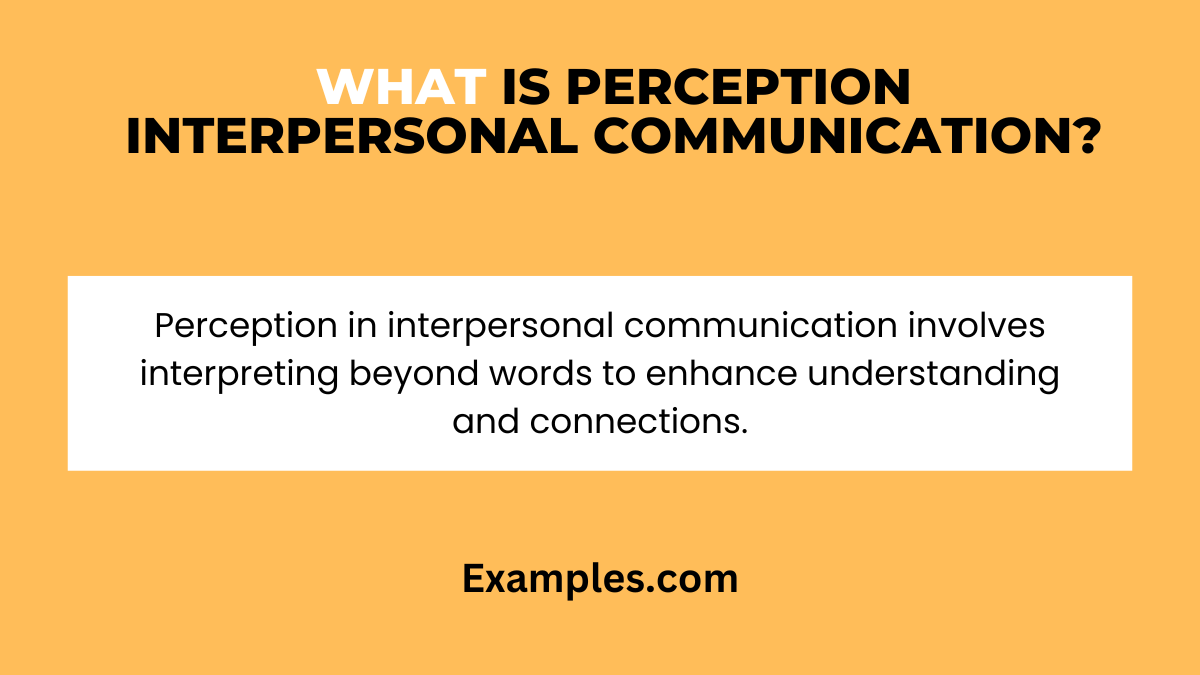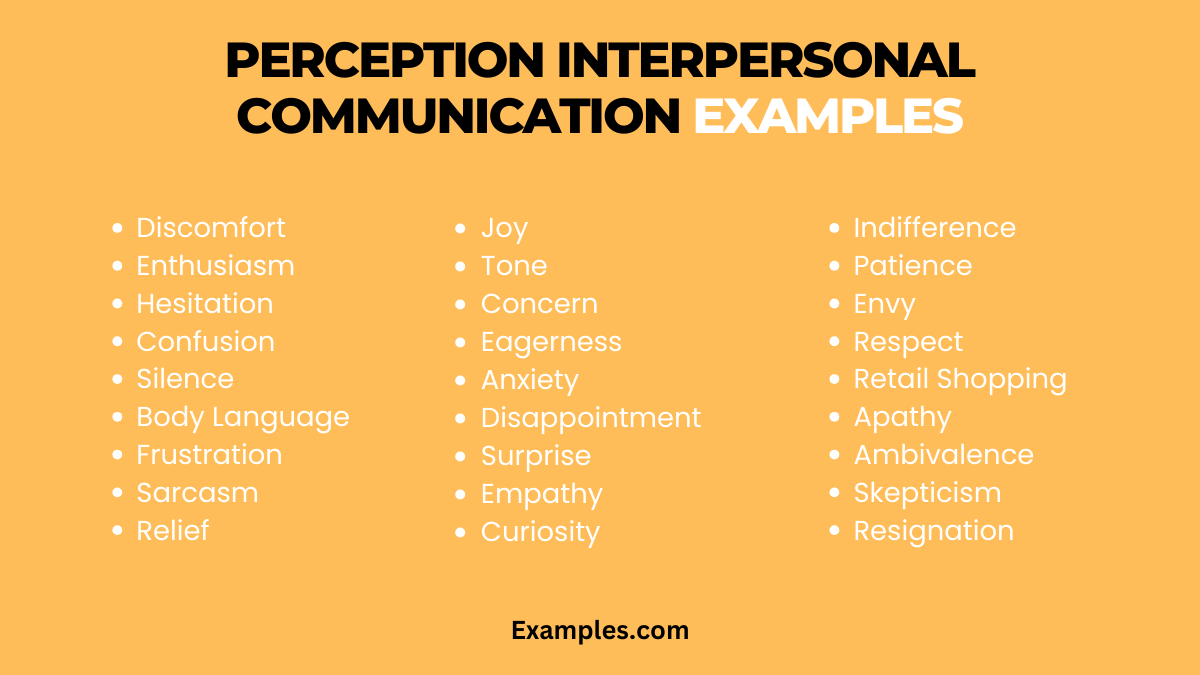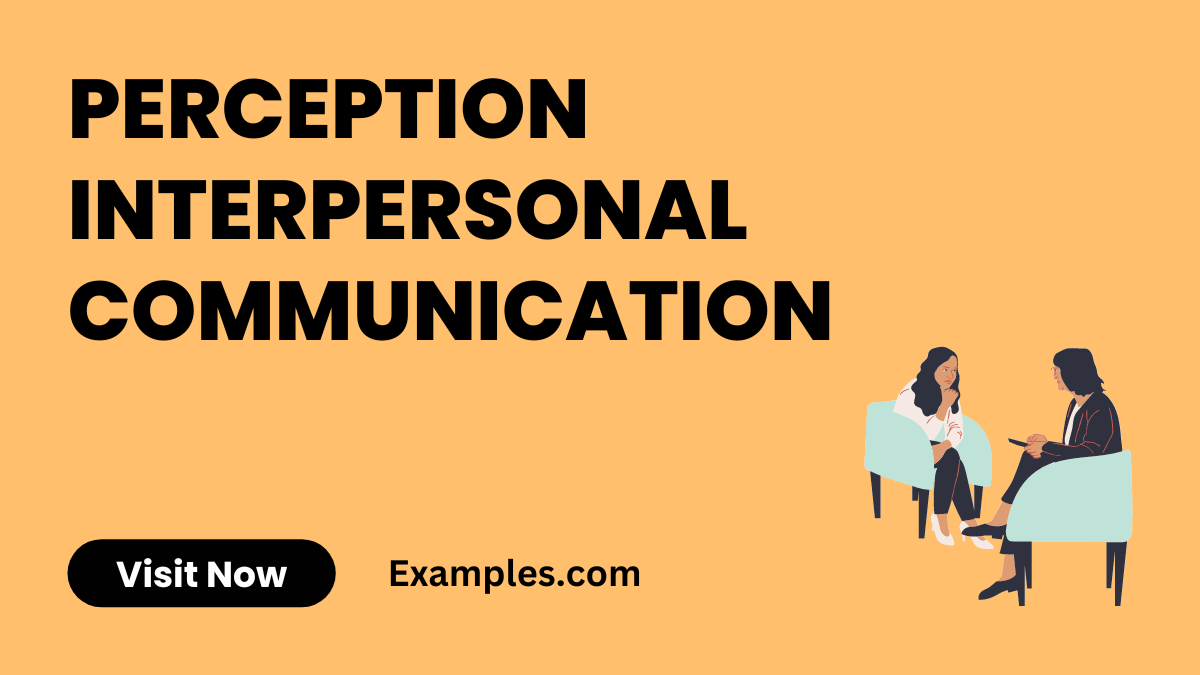14+ Perception Interpersonal Communication Examples
Perception in interpersonal communication is a crucial aspect that shapes how we interpret and respond to others. It includes understanding not just the words spoken, but also the underlying emotions, intentions, and cultural contexts. Effective oral communication relies heavily on perception, allowing us to navigate social nuances and build stronger, more empathetic relationships. Mastering this skill can lead to more successful and fulfilling personal and professional interactions.
What is Perception Interpersonal Communication? – Definition

Perception in interpersonal communication refers to the process of interpreting and understanding the messages conveyed by others. It’s not just about the words spoken; it involves discerning the non-verbal cues, tone, and context behind them. This perceptual process influences how we respond and interact, playing a key role in the effectiveness of our communication. Understanding this concept can greatly improve our ability to connect and communicate with others on a deeper level.
Perception Interpersonal Communication Examples

Perception in interpersonal communication plays a pivotal role in how we interpret and respond to others, influencing our personal and professional relationships. It encompasses understanding beyond words, recognizing non-verbal cues, tone, and emotional context. Skilled perception allows for deeper empathy and more effective communication, enhancing connections and fostering mutual understanding in various interactions.
- Recognizing Discomfort: “You seem a bit uncomfortable. Would you like to talk about it?”
- Identifying Enthusiasm: “I can see you’re excited about this project. What are your thoughts?”
- Understanding Hesitation: “You hesitated when I mentioned the deadline. Is there a concern?”
- Noticing Confusion: “You look a bit confused. Let me clarify that point.”
- Interpreting Silence: “I notice you’ve been quiet. Is there anything on your mind?”
- Reading Body Language: “Your crossed arms suggest you might disagree. What’s your view?”
- Sensing Frustration: “It sounds like you’re frustrated with the process. Let’s find a solution.”
- Decoding Sarcasm: “That sounded sarcastic. Are you actually okay with the decision?”
- Perceiving Relief: “You seem relieved. Did something good happen?”
- Detecting Boredom: “You appear disinterested. Is this topic not engaging for you?”
- Acknowledging Anger: “I can hear anger in your voice. Let’s address what’s upsetting you.”

- Noting Joy: “Your smile tells me you’re happy with the results.”
- Interpreting Tone: “Your tone seems hesitant. Do you have reservations?”
- Observing Concern: “Your expression shows concern. What are your worries?”
- Sensing Eagerness: “You sound eager to start. Shall we dive in?”
- Recognizing Anxiety: “Your nervousness is apparent. How can I help ease your anxiety?”
- Detecting Disappointment: “You seem disappointed. Did things not go as expected?”
- Noting Surprise: “That news seems to have surprised you. Any thoughts?”
- Understanding Empathy: “Your empathy is evident. It’s clear you care deeply.”
- Perceiving Skepticism: “You seem skeptical. What doubts do you have?”
- Recognizing Curiosity: “Your questions show you’re curious. Let’s explore more.”
- Sensing Resignation: “There’s a sense of resignation in your words. What’s behind that?”
- Decoding Indifference: “Your lack of reaction seems like indifference. Is that the case?”
- Noting Patience: “Your patience in this situation is admirable. How do you stay so calm?”
- Detecting Envy: “I sense a hint of envy in your comment. What’s on your mind?”
- Recognizing Respect: “The way you spoke shows great respect. It’s appreciated.”
- Observing Apathy: “There’s an air of apathy in your response. Are you disinterested?”
- Perceiving Ambivalence: “Your mixed reactions suggest ambivalence. Can you elaborate?”
- Noting Sarcasm: “That sounded sarcastic. Are you actually okay with the plan?”
- Recognizing Optimism: “Your positive outlook is refreshing. What makes you so optimistic?”
Explain the Ways of Perception in Interpersonal Communication
Perception in interpersonal communication is multifaceted, involving the interpretation of verbal and non-verbal cues to understand others’ messages and intentions. Here are key ways perception plays a role:
- Interpreting Verbal Messages: It’s not just about the words used but how they are said. Tone, pace, and inflection offer clues about the speaker’s true meaning.
- Reading Non-Verbal Cues: Body language, facial expressions, and gestures can convey emotions and attitudes that words alone may not.
- Understanding Context: The context in which communication occurs—be it cultural, social, or environmental—influences how messages are perceived and interpreted.
- Evaluating Emotional States: Perception helps in identifying the emotional states of others, be it happiness, anxiety, or frustration, impacting how we respond in communication.
- Assessing Intentions: Through perception, we can infer the intentions behind others’ messages, whether they are genuine, sarcastic, or deceptive.
- Recognizing Personal Biases: Our own experiences and biases affect how we perceive others’ communication. Being aware of these biases is crucial for objective understanding.
What is the Role of Perception in Interpersonal Communication?
The role of perception in interpersonal communication is vital, as it shapes the entire communication process and influences the outcomes of interactions. Here’s how:
- Facilitates Understanding: Accurate perception allows for a deeper understanding of the message being communicated, leading to more effective responses.
- Aids in Relationship Building: By correctly perceiving others’ emotions and intentions, stronger, more empathetic relationships can be built.
- Enhances Communication Effectiveness: Perception helps in tailoring communication strategies to suit different situations and individuals, improving the effectiveness of interactions.
- Prevents Misunderstandings: Good perception skills can help identify potential misunderstandings before they escalate, maintaining harmony in communication.
- Supports Conflict Resolution: In conflicts, perception plays a role in understanding different viewpoints and finding common ground.
- Promotes Empathy: By understanding others’ perspectives, perception fosters empathy, an essential component in interpersonal communication.
- Influences Decision Making: In professional settings, perception helps in making informed decisions based on the understanding of others’ inputs and reactions.
How Perception Influences Interpersonal Communication?
Perception significantly influences interpersonal communication, shaping how messages are understood, interpreted, and responded to. It’s a dynamic process that plays a key role in all forms of interaction, whether personal or professional.
- Interpreting Messages: Perception affects how we decode and interpret messages. The way we perceive words, tone, and context can alter the intended meaning of a message. For instance, the same statement can be interpreted differently based on the speaker’s tone, potentially leading to misunderstandings if not perceived accurately.
- Influencing Responses: Our responses in communication are largely driven by how we perceive the speaker’s message and intent. A message perceived as positive might elicit a cooperative response, while a message perceived as hostile might lead to a defensive reaction.
- Guiding Non-Verbal Communication: Much of interpersonal communication is non-verbal. Perception helps in understanding these silent messages conveyed through body language, facial expressions, and gestures. Misinterpreting these cues can lead to miscommunications and strained relationships.
- Impacting Listening Skills: Effective listening is a critical aspect of interpersonal communication. Perception influences how we listen and what we focus on during conversations. Active and empathetic listening requires accurately perceiving the emotions and intentions behind the spoken words.
- Shaping Emotional Intelligence: Perception is key to emotional intelligence, which involves understanding and managing emotions – both ours and others’. This understanding is vital in navigating sensitive conversations and maintaining positive interactions.
- Determining Cultural Interpretations: In our increasingly globalized world, interpersonal communication often crosses cultural boundaries. Perception plays a crucial role in understanding and respecting cultural differences in communication styles, helping to avoid cultural misunderstandings.
- Influencing Personal Biases: Our personal experiences, biases, and preconceived notions can shape our perceptions. Being aware of and adjusting these biases is crucial for objective understanding and effective interpersonal communication.
- Facilitating Empathy and Rapport: Accurate perception allows us to empathize with others, understanding their feelings and viewpoints. This empathy is essential for building rapport and trust in relationships, whether in personal life or the workplace.
Perception’s role in interpersonal communication is profound. It influences how messages are received, interpreted, and responded to, playing a critical role in the success and effectiveness of communication efforts. Being aware of and honing our perceptual skills can lead to more meaningful and productive interactions.



